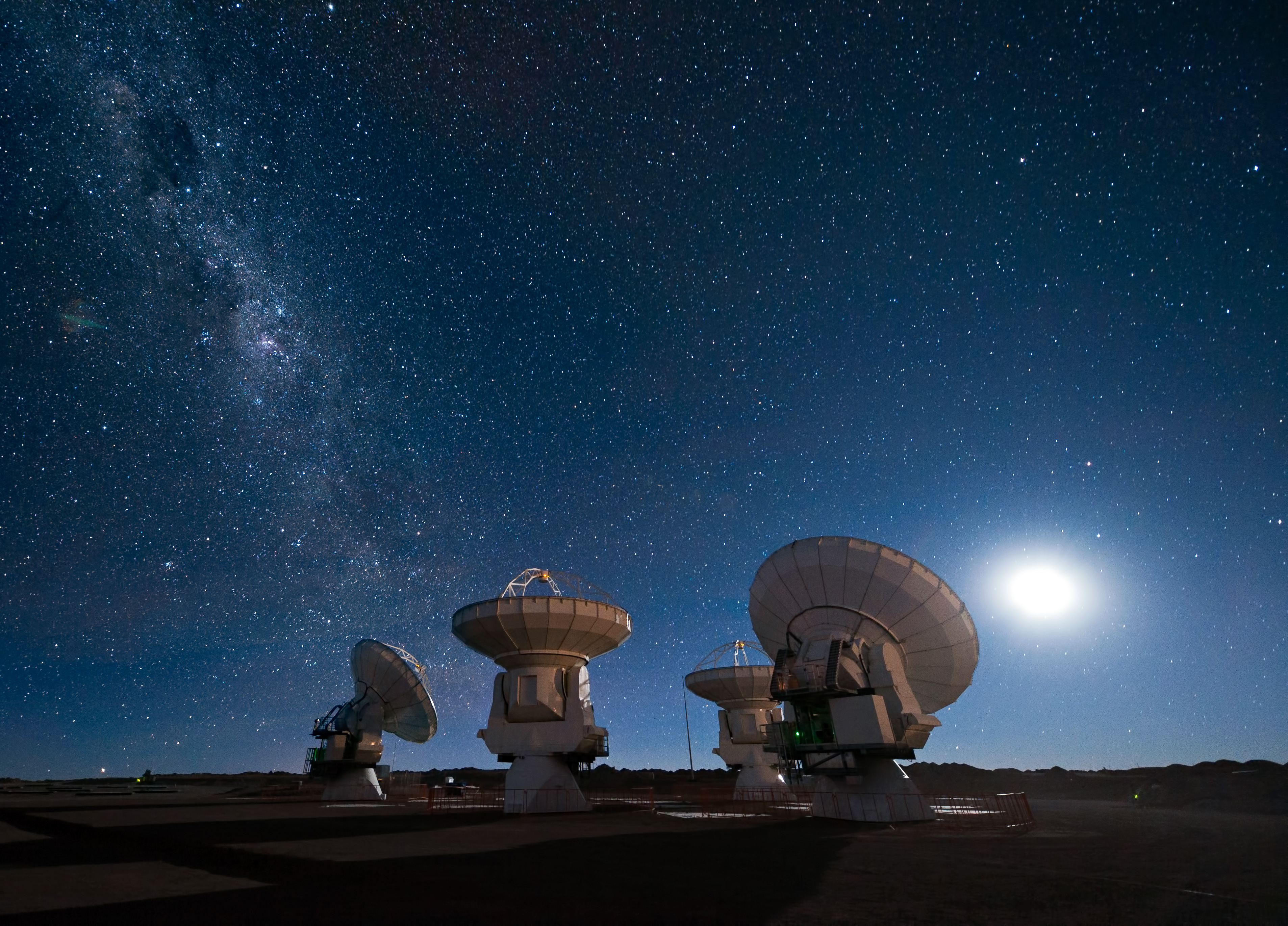|
Piwnice Radio Observatory
The Institute of Astronomy of Nicolaus Copernicus University in Toruń, known prior to 1 October 2019 in scientific publications as the Toruń Centre for Astronomy, is an optical and radio observatory located at () in Piwnice, about 15 km north of Toruń, Poland. It houses two single-dish antenna telescopes, 32 metres and 15 metres in diameter, as well as the largest Polish optical telescope – 90 cm Schmidt-Cassegrain camera. The facility is operated by the Nicolaus Copernicus University. Also, photometry using 60 cm Cassegrain telescope is made and radio measurements of the Sun at 127 MHz frequency have been recorded on a daily basis since 1958 using a 23 m interferometer. Radio astronomy Since 1981 the observatory has been a part of worldwide network of radio telescopes participating in VLBI (Very Long Baseline Interferometry). The 32 m telescope is a 620-ton construction designed by Zygmunt Bujakowski based on initial geometric parame ... [...More Info...] [...Related Items...] OR: [Wikipedia] [Google] [Baidu] |
Pulsars
A pulsar (from ''pulsating radio source'') is a highly magnetized rotating neutron star that emits beams of electromagnetic radiation out of its magnetic poles. This radiation can be observed only when a beam of emission is pointing toward Earth (similar to the way a lighthouse can be seen only when the light is pointed in the direction of an observer), and is responsible for the pulsed appearance of emission. Neutron stars are very dense and have short, regular rotational periods. This produces a very precise interval between pulses that ranges from milliseconds to seconds for an individual pulsar. Pulsars are one of the candidates for the source of ultra-high-energy cosmic rays. (See also centrifugal mechanism of acceleration.) The periods of pulsars make them very useful tools for astronomers. Observations of a pulsar in a binary neutron star system were used to indirectly confirm the existence of gravitational radiation. The first extrasolar planets were discovered aroun ... [...More Info...] [...Related Items...] OR: [Wikipedia] [Google] [Baidu] |
Radio Observatories
Radio is the technology of signaling and communicating using radio waves. Radio waves are electromagnetic waves of frequency between 30 hertz (Hz) and 300 gigahertz (GHz). They are generated by an electronic device called a transmitter connected to an antenna which radiates the waves, and received by another antenna connected to a radio receiver. Radio is very widely used in modern technology, in radio communication, radar, radio navigation, remote control, remote sensing, and other applications. In radio communication, used in radio and television broadcasting, cell phones, two-way radios, wireless networking, and satellite communication, among numerous other uses, radio waves are used to carry information across space from a transmitter to a receiver, by modulating the radio signal (impressing an information signal on the radio wave by varying some aspect of the wave) in the transmitter. In radar, used to locate and track objects like aircraft, ships, spacecraf ... [...More Info...] [...Related Items...] OR: [Wikipedia] [Google] [Baidu] |
Monthly Notices Of The Royal Astronomical Society
''Monthly Notices of the Royal Astronomical Society'' (MNRAS) is a peer-reviewed scientific journal covering research in astronomy and astrophysics. It has been in continuous existence since 1827 and publishes letters and papers reporting original research in relevant fields. Despite the name, the journal is no longer monthly, nor does it carry the notices of the Royal Astronomical Society. History The first issue of MNRAS was published on 9 February 1827 as ''Monthly Notices of the Astronomical Society of London'' and it has been in continuous publication ever since. It took its current name from the second volume, after the Astronomical Society of London became the Royal Astronomical Society (RAS). Until 1960 it carried the monthly notices of the RAS, at which time these were transferred to the newly established ''Quarterly Journal of the Royal Astronomical Society'' (1960–1996) and then to its successor journal ''Astronomy & Geophysics'' (since 1997). Until 1965, MNRAS ... [...More Info...] [...Related Items...] OR: [Wikipedia] [Google] [Baidu] |
List Of Radio Telescopes
This is a list of radio telescopes – over one hundred – that are or have been used for radio astronomy. The list includes both single dishes and interferometric arrays. The list is sorted by region, then by name; unnamed telescopes are in reverse size order at the end of the list. The first radio telescope was invented in 1932, when Karl Jansky at Bell Telephone Laboratories observed radiation coming from the Milky Way. Africa Antarctica Asia Australia Europe North America South America Arctic Ocean Atlantic Ocean Indian Ocean Pacific Ocean Space-based Under construction or planned construction Proposed telescopes Gallery of big dishes File:FastTelescope*8sep2015.jpg, alt=Five hundred meter Aperture Spherical Telescope under construction, The 500 meter Five hundred meter Aperture Spherical Telescope (FAST), under construction, China (2016) File:GBT.png, alt=Green Bank Telescope, The 100 meter Green Bank Telescope, ... [...More Info...] [...Related Items...] OR: [Wikipedia] [Google] [Baidu] |
Jena Observatory
Astrophysikalisches Institut und Universitäts-Sternwarte Jena (AIU Jena, Astrophysical Institute and University Observatory Jena, or simply Jena Observatory) is an astronomical observatory owned and operated by Friedrich Schiller University of Jena. It is located in Großschwabhausen close to Jena, Germany. WASP-3c & TTV Transit Timing Variation (TTV), a variation on the transit method, was used to discover an exoplanet WASP-3c by Rozhen Observatory, Jena Observatory, and Toruń Centre for Astronomy.http://www.scientificcomputing.com/news-DS-Planet-Hunting-Finding-Earth-like-Planets-071910.aspx "Planet Hunting: Finding Earth-like Planets" See also * List of astronomical observatories This is a list of astronomical observatories ordered by name, along with initial dates of operation (where an accurate date is available) and location. The list also includes a final year of operation for many observatories that are no longer in ... References External links Jena ... [...More Info...] [...Related Items...] OR: [Wikipedia] [Google] [Baidu] |
Rozhen Observatory
Rozhen Observatory ( bg, Национална астрономическа обсерватория - Рожен, ''НАО-Рожен''; en, National Astronomical Observatory - Rozhen, ''NAO-Rozhen''), also known as the Bulgarian National Astronomical Observatory, is an astronomical observatory, located in the Smolyan Province, 90 kilometers south of the city of Plovdiv, Bulgaria. The nearest town, Chepelare, is 15 kilometers away. The observatory is owned and operated by the Institute of Astronomy of the Bulgarian Academy of Sciences (BAS). It was officially opened on 13 March 1981, almost 20 years after Bogomil Kovachev – a professor of astronomy at BAS, known as its founder – had started working towards that goal. The Observatory is the largest in Southeastern Europe and has an active team of about 50 astronomers. It is the principal center for astronomical research in Bulgaria. The minor planet 6267 Rozhen, was discovered at, and named after the observatory. With its to ... [...More Info...] [...Related Items...] OR: [Wikipedia] [Google] [Baidu] |
WASP-3c
WASP-3 is a magnitude 10 yellow-white dwarf star located about 800 light-years away in the Lyra constellation. It appears to be variable; it "passed from a less active (log R'_hk=-4.95) to a more active (log R'_hk=-4.8) state between 2007 and 2010". Planetary system The extrasolar planet WASP-3b was detected by the SuperWASP project in 2007. The William Herschel Telescope had confirmed it was a planet by 2008. In 2010, researchers proposed a second planet orbiting WASP-3. But in 2012 this proposal was debunked. See also * SuperWASP * WASP-4 WASP-4 is a G-type main sequence star approximately 891 light-years away in the constellation of Phoenix. Despite its advanced age, the star is rotating rapidly, being spun up by the tides raised by a giant planet on close orbit. Plan ... References External links * {{Stars of Lyra Lyra (constellation) F-type subgiants Planetary transit variables Planetary systems with one confirmed planet 3 J1834 ... [...More Info...] [...Related Items...] OR: [Wikipedia] [Google] [Baidu] |
Transit Timing Variation
Transit-timing variation is a method for detecting exoplanets by observing variations in the timing of a transit. This provides an extremely sensitive method capable of detecting additional planets in the system with masses potentially as small as that of Earth. In tightly packed planetary systems, the gravitational pull of the planets among themselves causes one planet to accelerate and another planet to decelerate along its orbit. The acceleration causes the orbital period of each planet to change. Detecting this effect by measuring the change is known as transit-timing variations. "Timing variation" asks whether the transit occurs with strict periodicity or if there's a variation. The first significant detection of a non-transiting planet using transit-timing variations was carried out with NASA's Kepler telescope. The transiting planet Kepler-19b shows transit-timing variation with an amplitude of 5 minutes and a period of about 300 days, indicating the presence of a second p ... [...More Info...] [...Related Items...] OR: [Wikipedia] [Google] [Baidu] |
Astronomers
An astronomer is a scientist in the field of astronomy who focuses their studies on a specific question or field outside the scope of Earth. They observe astronomical objects such as stars, planets, natural satellite, moons, comets and galaxy, galaxies – in either observational astronomy, observational (by analyzing the data) or theoretical astronomy. Examples of topics or fields astronomers study include planetary science, Sun, solar astronomy, the Star formation, origin or stellar evolution, evolution of stars, or the galaxy formation and evolution, formation of galaxies. A related but distinct subject is physical cosmology, which studies the Universe as a whole. Types Astronomers usually fall under either of two main types: observational astronomy, observational and theoretical astronomy, theoretical. Observational astronomers make direct observations of Astronomical object, celestial objects and analyze the data. In contrast, theoretical astronomers create and investigate C ... [...More Info...] [...Related Items...] OR: [Wikipedia] [Google] [Baidu] |
Frequency Converters
A frequency changer or frequency converter is an Electronics, electronic or electromechanical device that converts alternating current (Alternating current, AC) of one frequency to alternating current of another frequency. The device may also change the voltage, but if it does, that is incidental to its principal purpose, since voltage conversion of alternating current is much easier to achieve than frequency conversion. Traditionally, these devices were electromechanical machines called a motor-generator set. Also devices with mercury arc rectifiers or vacuum tubes were in use. With the advent of solid state electronics, it has become possible to build completely electronic frequency changers. These devices usually consist of a rectifier stage (producing direct current) which is then inverted to produce AC of the desired frequency. The inverter (electrical), inverter may use thyristors, Integrated gate-commutated thyristor, IGCTs or Insulated-gate bipolar transistor, IGBTs. If vo ... [...More Info...] [...Related Items...] OR: [Wikipedia] [Google] [Baidu] |
Spectrometers
A spectrometer () is a scientific instrument used to separate and measure spectral components of a physical phenomenon. Spectrometer is a broad term often used to describe instruments that measure a continuous variable of a phenomenon where the spectral components are somehow mixed. In visible light a spectrometer can separate white light and measure individual narrow bands of color, called a spectrum. A mass spectrometer measures the spectrum of the masses of the atoms or molecules present in a gas. The first spectrometers were used to split light into an array of separate colors. Spectrometers were developed in early studies of physics, astronomy, and chemistry. The capability of spectroscopy to determine chemical composition drove its advancement and continues to be one of its primary uses. Spectrometers are used in astronomy to analyze the chemical composition of stars and planets, and spectrometers gather data on the origin of the universe. Examples of spectrometers are d ... [...More Info...] [...Related Items...] OR: [Wikipedia] [Google] [Baidu] |







